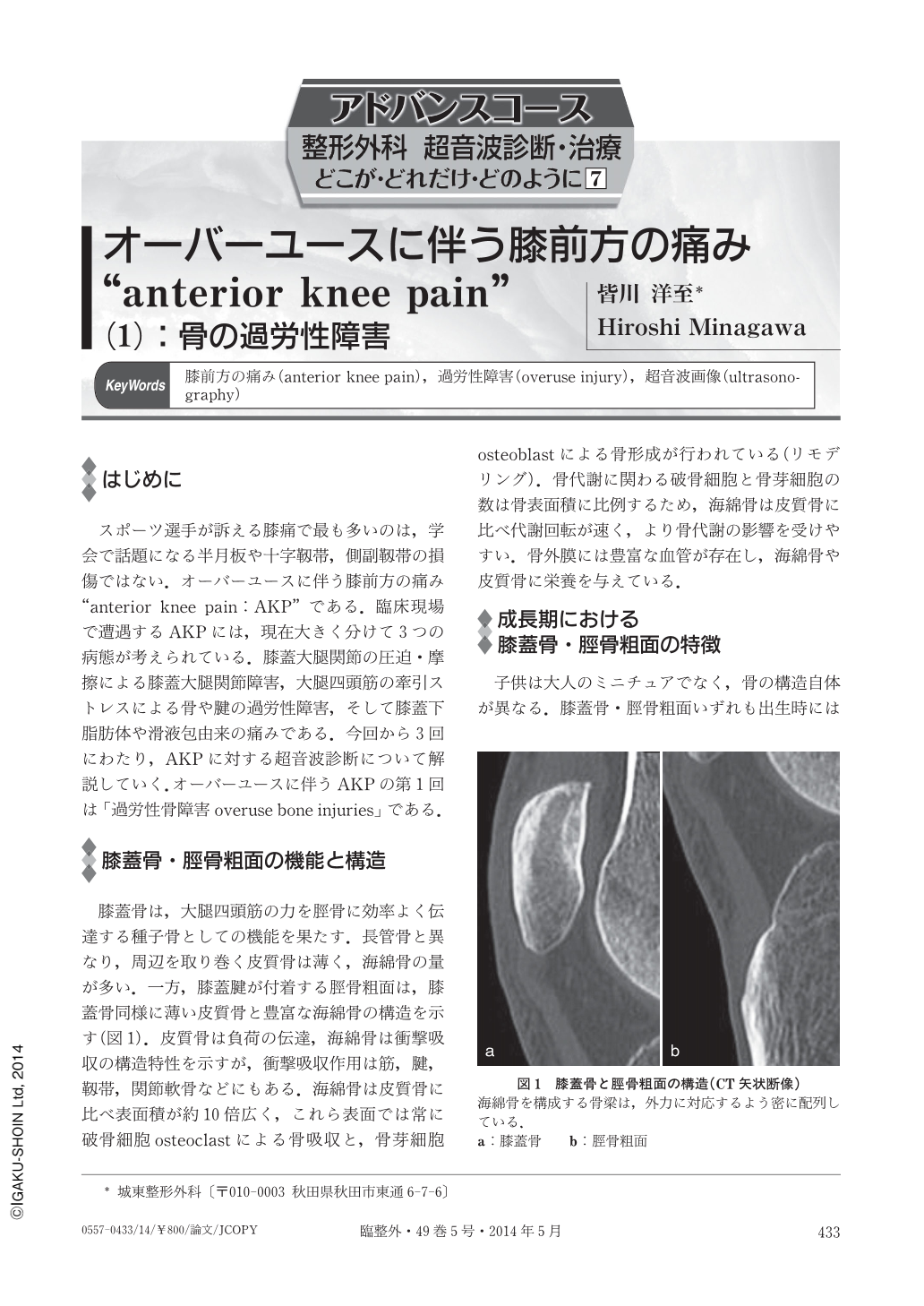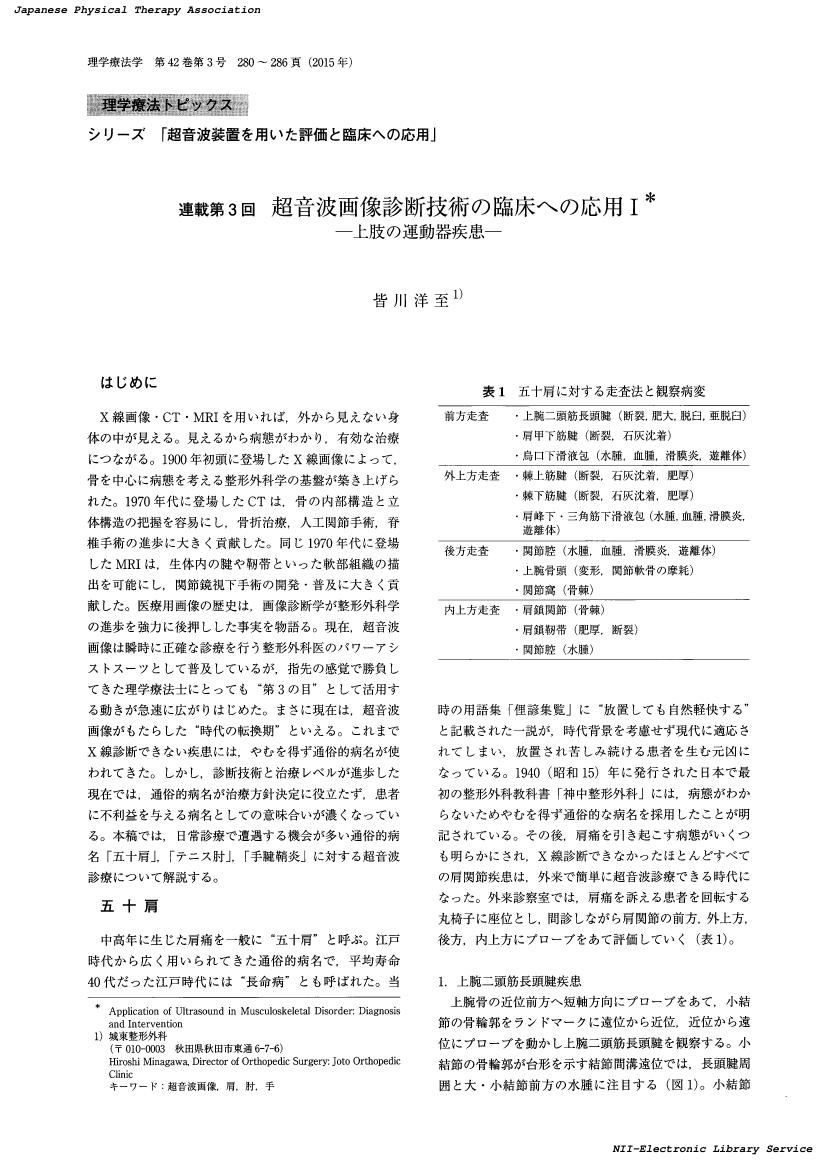2 0 0 0 OA 成長期野球肘外側・内側障害と円回内筋の硬さとの関係
- 著者
- 齊藤 明 皆川 洋至 渡部 裕之 川崎 敦 岡田 恭司
- 出版者
- 公益社団法人 日本理学療法士協会
- 雑誌
- 理学療法学Supplement Vol.43 Suppl. No.2 (第51回日本理学療法学術大会 抄録集)
- 巻号頁・発行日
- pp.1262, 2016 (Released:2016-04-28)
【はじめに,目的】成長期野球肘は骨軟骨障害が主体であり,肘関節外側では上腕骨小頭,内側では上腕骨内側上顆に発生する事が多い。いずれも投球時の肘関節外反が関与するとされており,その制動には前腕回内・屈筋群が働くと考えられている。臨床においてもこれらの筋の硬さは頻繁に経験するが,成長期野球肘の外側・内側障害との関係は明らかにされていない。本研究の目的は,超音波エラストグラフィ(Real-timeTissue Elastography:RTE)を用いて円回内筋の硬さと成長期野球肘の外側障害および内側障害との関係を明らかにし,予防や治療の一助とすることである。【方法】A県野球少年団に所属する離断性骨軟骨炎患者8名(外側障害群:平均年齢11.3歳),野球肘内側障害患者27名(内側障害群:平均年齢11.5歳),健常小学生43名(対照群:平均年齢10.5歳)を対象に,RTEを用いて投球側,非投球側の円回内筋の硬さを測定した。測定肢位は椅子座位で肘関節屈曲30度位,前腕回外位とし,円回内筋の撮像部位は短軸像で上腕骨滑車を描出した後,プローブを遠位へ平行移動させ上腕骨滑車が消失した位置とした。硬さの解析には円回内筋のひずみ量に対する音響カプラーのひずみ量の比であるStrain Ratio(SR)を用いた。SRは値が大きいほど円回内筋が硬いことを意味する。また投球側,非投球側の前腕回外可動域を計測した。統計解析にはSPSS22.0を使用し,3群間でのSR,前腕回外可動域の比較には一元配置分散分析,各群における投球側と非投球側との比較には対応のあるt検定を用いた。【結果】投球側の円回内筋のSRは外側障害群1.77±0.39,内側障害群1.34±0.59,対照群0.88±0.34で外側障害群が内側障害群,対照群に比べ有意に大きく(それぞれp=0.050,p<0.001),内側障害群が対照群より有意に高値であった(p<0.001)。非投球側の円回内筋のSRは外側障害群1.02±0.31,内側障害群1.31±0.59,対照群0.89±0.30で内側障害群が対照群に比べて有意に大きかった(p<0.001)が,その他では有意差は認められなかった。各群における円回内筋のSRの投球側と非投球側との比較では,外側障害群で投球側が非投球側に比べ有意に高値を示した(p<0.001)が,内側障害群,対照群では有意差は認められなかった。前腕回外角度は投球側,非投球側とも3群間で有意差は認められなかった。【結論】成長期野球肘の外側障害および内側障害では,非障害肘に比べ投球側の円回内筋が硬いことが明らかとなった。特に外側障害では非投球側に比べ投球側でより硬く,内側障害では両側とも硬いことが特徴であると考えられる。また一般に臨床で用いられる前腕回外可動域は,これらの障害の特徴を反映しないことが示唆された。
はじめに スポーツ選手が訴える膝痛で最も多いのは,学会で話題になる半月板や十字靱帯,側副靱帯の損傷ではない.オーバーユースに伴う膝前方の痛み“anterior knee pain:AKP”である.臨床現場で遭遇するAKPには,現在大きく分けて3つの病態が考えられている.膝蓋大腿関節の圧迫・摩擦による膝蓋大腿関節障害,大腿四頭筋の牽引ストレスによる骨や腱の過労性障害,そして膝蓋下脂肪体や滑液包由来の痛みである.今回から3回にわたり,AKPに対する超音波診断について解説していく.オーバーユースに伴うAKPの第1回は「過労性骨障害overuse bone injuries」である.
1 0 0 0 腱板断裂に伴う腱板構成筋サルコメア長の特徴について
- 著者
- 冨岡 立 皆川 洋至 木島 泰明 山本 宣幸 阿部 秀一 菊池 一馬 島田 洋一
- 出版者
- 日本肩関節学会
- 雑誌
- 肩関節 (ISSN:09104461)
- 巻号頁・発行日
- vol.32, no.2, pp.225-228, 2008 (Released:2008-08-30)
- 参考文献数
- 13
- 被引用文献数
- 1
Structural changes of rotator cuff muscle after torn rotator cuff tendon are the muscle atrophy, the shortening of muscle fiber length, and fatty infiltration. However, there is no report about the sarcomere length which is one of the factors related to the contractile ability of muscle. The purpose of this study was to clarify the sarcomere length of torn rotator cuff muscle. 14 embalmed cadaver shoulders were enrolled in this study. The average age was 82 years old (range: 74-91). There were 7 full-thickness rotator cuff tear shoulders and 7 normal shoulders. Muscle fiber length was measured using a digital caliper. Sarcomere length of the rotator cuff muscle was determined by laser diffraction.In the cuff tear group, muscle fiber length of the supraspinatus: SSP, infraspinatus: ISP, teres minor: TM, and subscapularis: SSC was 33.2±6.3mm, 70.6±9.9mm, 57.4±6.4mm, and 58.2±9.6mm, respectively. In the normal cuff group, that of SSP, ISP, TM, and SSC was 57.3±13.7mm, 73.4±14.0mm, 58.2±11.2mm, and 57.8±11.7mm, respectively. The muscle fiber length of SSP in the cuff tear group was significantly shorter than that of SSP in the normal cuff group (P=0.0157). ISP, TM, and SSC showed no significant difference in the muscle fiber length. In the cuff tear group, the sarcomere length of SSP, ISP, TM, and SSC were 3.07±0.41μm, 3.16±0.42μm, 2.80±0.27μm, and 2.41±0.21μm, respectively. In the normal cuff group, those of SSP, ISP, TM, and SSC were 3.18±0.46μm, 3.21±0.57μm, 3.13±0.34μm, and 2.60±0.22μm, respectively. There was no significant difference in the sarcomere length. Although the muscle fiber length of SSP with rotator cuff tear was significantly shorter than that of SSP without rotator cuff tear, the sarcomere length of SSP had no significant difference between the cuff tear group and the intact cuff group. These results indicate that the number of sarcomere may reduce to adapt the shortened muscle fiber length of supraspinatus to maintain muscle contractile ability.
1 0 0 0 OA 腱板を構成する筋の筋内腱 -筋外腱移行形態について-
- 著者
- 皆川 洋至 井樋 栄二 佐藤 毅 今野 則和 本郷 道生 佐藤 光三
- 出版者
- 日本肩関節学会
- 雑誌
- 肩関節 (ISSN:09104461)
- 巻号頁・発行日
- vol.20, no.1, pp.103-109, 1996-10-15 (Released:2012-11-20)
- 参考文献数
- 14
- 被引用文献数
- 3
Each muscle of the rotator cuff is known to have several intramuscular tendons which provide attachment to numerous muscle fiders. The anatomical relationship between intramuscular and extramuscular tendons needs to be determined to know the distribution of the force to the rotator cuff tendon. The purpose of this study was to clarify the morphology of the transitional zone of intramuscular to extramuscular tendons of the rotator cuff.The muscle fibers of cuff muscles of 20 embalmed shoulders without full-thickness rotator cuff tears were removed to examine the transitional zone of the intramuscular to extramuscular tendons macroscopically. Histological sections of the musculotendinous junction were perpared to evaluate the transitional forms microscopically.We defined the intramuscular tendon as the tendon inside the muscle belly and the extramuscular tendon as the tendon outside the muscle. The extramuscular tendons from the rotator cuff tendon distally. Location was expressed as the % position of the anterior and posterior margins of the musculotendinous junction. The intramuscular tendons of the infraspinatus, teres minor, and subscapularis were contiguous to the whole extramuscular tendons and that the supraspinatus was located in the anterior one-third of the extramuscular tendon(0±0% to 28±15%). Microscopically, the intramuscular tendon of the supraspinatus formed a tendon fiber bundle and was continuous with the second of five layers of the extramuscular tendon (Clark and Harryman,1992).Conclusion: The connection of intramuscular tendon to extramuscular tendon was specific to each cuff muscle. The intramuscular tendon of the supraspinatus was attached to the anterior one-third of the extramuscular tendon and was contiguous to the second layer.
1 0 0 0 OA オスグッド病の超音波検診
- 著者
- 西川 志津 山口 睦弘 皆川 洋至
- 出版者
- 一般社団法人 日本超音波検査学会
- 雑誌
- 超音波検査技術 (ISSN:18814506)
- 巻号頁・発行日
- vol.35, no.3, pp.285-289, 2010-06-01 (Released:2010-06-25)
- 参考文献数
- 8
- 著者
- 皆川 洋至
- 出版者
- 日本理学療法士学会
- 雑誌
- 理学療法学 (ISSN:02893770)
- 巻号頁・発行日
- vol.42, no.3, pp.280-286, 2015-06-20 (Released:2017-06-09)
1 0 0 0 OA クリニカルパスによる入院日数短縮の要因 : 人工股関節全置換術について
- 著者
- 高山 賢路 齋藤 千鶴子 佐藤 真貴子 熊谷 ナミコ 浅沼 義博 久保田 均 皆川 洋至 渡部 亘 井樋 栄二
- 出版者
- 秋田大学
- 雑誌
- 秋田大学医学部保健学科紀要 (ISSN:13478664)
- 巻号頁・発行日
- vol.13, no.1, pp.34-39, 2005-03-31
クリニカルパスを使用することで処置,介助,リハビリテーション(以下,リハビリ)のケア実施日が早くなったか,さらに入院日数がどれくらい短縮したかを明らかにする目的で,クリニカルパスを使用していない人工股関節全置換術(total hi parthroplasty ; THA)患者15例(以下,コントロール群)とクリニカルパスを使用した8例(以下,パス群)とを比較検討した.処置項目では,パス群の抗生剤投与期間が平均7日有意に短縮した.介助項目では,ヘッドアップ30度開始日が平均1日,ヘッドアップ自由開始日が平均3日,端座位開始日が平均2日有意に短縮した.リハビリ項目では,リハビリ室訓練が平均9日,全荷重立位が平均15日,松葉杖歩行が平均11日有意に開始日が早まった.平均入院日数は,術前14日,術後11日,全体で26日,パス群で有意に短縮していた.パス群8例の術後経過はすべて良好で,入院日数の短縮が術後成績に影響することはなかった.セメントTHAを行う患者にクリニカルパスを適用すれば,介助,リハビリの開始時期が早くなり,結果として入院日数短縮につながった



